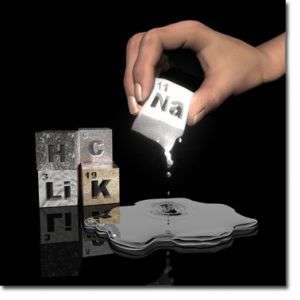Sodium loses its luster: A liquid metal that's not really metallic

When melting sodium at high pressures, the material goes through a transition in which its electrical conductivity drops threefold. In a series of new calculations, Lawrence Livermore National Laboratory scientists describe the unusual melting behavior of dense sodium.
“We found that molten sodium undergoes a series of pressure-induced structural and electronic transitions similar to those observed in solid sodium but beginning at a much lower pressure,” said LLNL’s Eric Schwegler.
Schwegler and former colleagues Stanimir Bonev, now at Dalhousie University in Nova Scotia, and Jeans-Yves Raty at FNRS-University of Liège in Belgium report the new findings in the Sept. 27 edition of the journal, Nature.
Earlier experimental measurements of sodium’s melting curve have shown an unprecedented pressure-induced drop in melting temperature from 1,000 K at 30 GPa (30,000 atmospheres of pressure) down to room temperature at 120 GPa (120 million atmospheres of pressure).
Usually when a solid melts, its volume increases. In addition, when pressure is increased, it becomes increasingly difficult to melt a material.
However, sodium tells a different story.
As pressure is increased, liquid sodium initially evolves into a more compact local structure. In addition, a transition takes place at about 65 GPa that is associated with a threefold drop in electrical conductivity.
The researchers carried out a series of first-principle molecular dynamic simulations between 5 and 120 GPa and up to 1,500 K to investigate the structural and electronic changes in compressed sodium that are responsible for the shape of its unusual melting curve.
The team discovered that in addition to a rearrangement of the sodium atoms in the liquid under pressure, the electrons were transformed as well. The electronic cloud gets modified; the electrons sometimes get trapped in interstitial voids of the liquid and the bonds between atoms adopt specific directions.
“This behavior is totally new in a liquid as we usually expect that metals get more compact with pressure,” Raty said.
Source: Lawrence Livermore National Laboratory




















